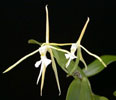|
|
|
|
|
| |
Flasks of
Epidendrum nocturnum 'MC286' × self |
|
| |
|
|
| |
|
|
Click to Enlarge

Pod Parent Flowers |
|
|
|
| |
For additional origin/habitat information supplied courtesy of
Charles and Margaret Baker, see further below, near the bottom of this page.
|
Temperatures we attempt to use in the lab & greenhouse:
| For Species: |
|
Spring, Summer, Autumn, Winter: days average 79°F, nights 62°F; best fit is Intermediate 83-60°F
(Source:
Baker's Web OSC) |
|
About the name...
| Etymology of |
Epidendrum |
|
From Greek "epi" upon; "dendron" tree.
(Source:
Pridgeon 1992) |
| Etymology of |
nocturnum |
|
From Latin "nocturnus" nightly. Referring to the strong fragrance during the night.
(Source:
Mayr & Schmucker 1998) |
| Pronunciation of |
Epidendrum |
|
eh-pee-DEN-drum
(Source:
Pridgeon 1992) |
| Pronunciation of |
nocturnum |
|
nok-TUR-num
(Source:
Hawkes 1978) |
|
If you would like to direct someone to this web page, please copy and paste this URL into your email:
http://troymeyers.com/d?011365
| Flask Information |
| Availability: |
Capsule failed. We were not able to make any flasks. |
| You should: |
Consider placing a "Notify Retries" Request, and if an identical pollination (the same parents) is done again, we'll let you know. |
|
You might also want to:
|
View items of the same species.
View items of the same genus.
|
| Ordering Information |
| You are not currently logged in. |
|
You must be a registered user and be logged in to reserve a flask or place a notification request. Please log in:
|
|
|
|
|
|
| |
The origin/habitat information below is supplied courtesy of Charles and Margaret Baker
The following information is based on the name of the plant provided by the donor, and assumes that the name is correct. If the plant has been misidentified, then the following information may not be correct.
This text is copyrighted by the Bakers and may not be reproduced without permission.
ORIGIN/HABITAT: Distributed from southern Florida, through Mexico and
Central America, the West Indies, and into northern South America as far
south as Peru, Bolivia, and Brazil. Plants grow mostly as epiphytes on
trees and rocks, but occasionally may grow as terrestrials. They are found
in both wet and dry regions, growing in tall, evergreen lowland forest, in
open fields, and disturbed forests. Plants most frequently are found at
elevations between 350 and 3300 ft. (100-1000 m), but collections have
been reported from as high as 6550 ft. (2000 m). This widely distributed
orchid has been collected many times, and a long list of collection
locations, elevations, and dates is available at Tropicos.
More about this information and the Bakers...
|
|
|
| |
|
|
|